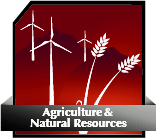Agriculture, Food & Natural Resources
Careers focused on the production, processing, marketing, distribution, financing, and development of agricultural commodities and resources including food, fiber, wood products, natural resources, horticulture, and other plant and animal products or resources.
Pathways
- Agribusiness Systems Pathway - People who coordinate all of the activities that contribute to the production, processing, marketing, distribution, financing and development of agricultural commodities and resources. This includes food, fiber, wood products, natural resources, horticulture, and other plant and animal products and services. Agribusiness is a high-tech industry that uses satellite systems, computer databases and spreadsheets, biotechnology and many other innovations to increase efficiency and profitability.
- Animal Systems Pathway - People who work to develop better, more efficient ways of producing and processing meat, poultry, eggs and dairy products. They study genetics, nutrition, reproduction, growth and development of domesticated farm animals. Some individuals inspect and grade livestock food products, purchase livestock or work in technical sales or marketing. Others advise agricultural producers on how to upgrade animal housing facilities properly, lower mortality rates, handle waste matter or increase production of animal products, such as milk or eggs. Animal care workers train, feed, water, groom, bathe and exercise animals. They also clean, disinfect and repair their cages.
- Environmental Service Systems Pathway - People who are involved in water and air pollution control, recycling, waste disposal and public health issues. Environmental engineers and technicians conduct hazardous-waste management studies, evaluate the significance of the hazard, offer analysis on treatment and containment, and develop regulations to prevent mishaps. They design municipal sewage and industrial wastewater systems. They analyze scientific data, research environmental projects and perform quality control checks.
- Food Products & Processing Systems Pathway - People who discover new food sources, analyze food content and develop ways to process, preserve, package or store food according to industry and government regulations. They create new food products to meet consumer needs and inspect food-processing areas to ensure that sanitation, safety, quality and waste management standards are met.
- Natural Resources Systems Pathway - People who perform a variety of tasks from helping to develop, maintain, and manage the forest and natural environment to catching and trapping various types of marine life for human consumption, animal feed, bait and other uses. Forest and rangelands supply wood products, livestock forage, minerals and water; serve as sites for recreational activities; and provide habitats for wildlife. Conservation scientists and foresters manage, develop, use and help protect these and other natural resources.
- Plant Systems Pathway - People who study plants and their growth. This helps producers of food, feed and fiber crops continue to feed a growing population while conserving natural resources and maintaining the environment. Individuals in this pathway also develop ways to improve the nutritional value of crops and the quality of seeds. They use genetic engineering to develop crops resistant to pests and drought.
- Power, Structural & Technical Systems Pathway - People who apply knowledge of engineering, hydraulics, pneumatics, electronics, power, structures, and controls to the field of agriculture. They design agricultural structures as well as machinery and equipment. They develop ways to conserve soil and water and to improve the processing of agricultural products.


